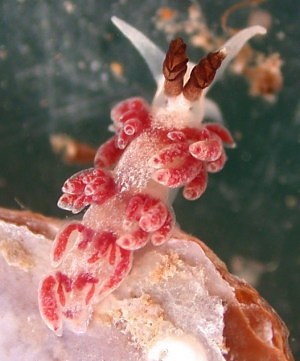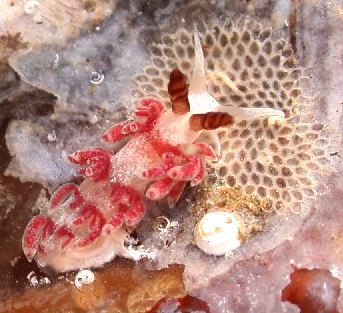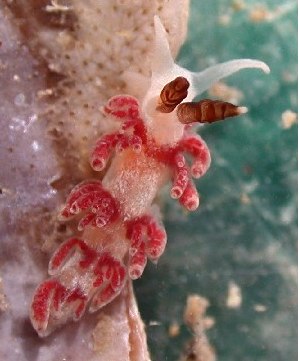
Favorinus elenalexiae
Garcia & Troncoso, 2001
Order: NUDIBRANCHIA
Suborder: AEOLIDINA
Family: Glaucidae
DISTRIBUTION
West coast of central America [Baja California, Mexico to Panama]
PHOTO
Islas Marietas, Bahia de Banderas, Pacific Coast of Mexico, 10mm long, 30 feet deep, May 5th 2002. Photo: Alicia Hermosillo
The body is translucent with scattered opaque white spots and patches. The most distinctive feature of Favorinus elenalexiae are the shape of the dark brown rhinophores, with three 'cup-shaped' or 'collar-like' swellings identical to those of F. tsuruganus. The digestive gland ducts are pinkish, with no reports of them changing colour [see message]. Like all species of the genus, it eats the eggs of other opisthobranchs.
Reference:
• Garcia, F.J. & Troncosa, J.S., 2001 Favorinus elenalexiae, a new species (Opisthobranchia: Aeolidiidae) from the eastern Pacific Ocean. The Nautilus, 115(2): 55-61 figs 1-7.
• Garcia, F.J. & Troncosa, J.S., 2001. Correction of a mistake introduced in the description of an aeolid nudibranch of the genus Favorinus Gray, 1850. The Nautilus, 115(4): 150
Rudman, W.B., 2002 (August 11) Favorinus elenalexiae Garcia & Troncoso, 2001. [In] Sea Slug Forum. Australian Museum, Sydney. Available from http://www.seaslugforum.net/find/favoelen
Related messages
Re: Favorinus elenalexiae or F. elenalexiarum
September 14, 2002
From: Gary Rosenberg
Hi Bill,
Re your question about this name and the International Code:
Article 32.5 does allow for correction of errors in gender agreement, because they are not errors in transliteration or latinization, but errors of grammar.
Transliteration converts non-Latin characters to Latin ones: for example "Warén" becomes "Varen", since W and accented E do not occur in Latin. However, article 32.5 allows "Waren" to stand even though technically it is an error of transliteration.
Latinization converts a word to a Latin basis, so "Waren" becomes "Warenius" or "Warenus". The grammatical step then makes "warenii" or "wareni". The case of compound names however is tricky. "Elenalexia" is not necessarily plural in nature. Most languages treat compound words as singular: bearcat, Salvini-Plawen, camelopardalis. The code implies in Article 31.2.3 that gender agreement of compound words is determined by the final component of the word.
In the case of Elena + Alexia, if the authors intended it to be singular, the basis would have been "Elenalexia", with genitive "elenalexiae". If the authors intending it to be plural, the basis would have been "Elenalexiae" with genitive "elenalexiarum". Unfortunately the authors did not state the basis, but it seems to me that the choice between the bases is part of the latinization, and cannot be corrected. Also, "Elenalexiae" can be construed as a plural noun in apposition, and cannot be changed in that case either. Basically I think it would be wrong to correct the name to "elenalexiarum".
Best wishes,
Gary
Gary Rosenberg
Academy of Natural Sciences, Philadelphia
rosenberg@acnatsci.org
Rosenberg, G., 2002 (Sep 14) Re: Favorinus elenalexiae or F. elenalexiarum. [Message in] Sea Slug Forum. Australian Museum, Sydney. Available from http://www.seaslugforum.net/find/7956Thanks Gary,
Bill Rudman
Re: Favorinus elenalexiae or F. elenalexiarum
August 16, 2002
From: Dave Behrens
Bill:
In this specific case, the rules do state that a trivial name or patronym recognizing 2 or more persons will end in -arum or -orum. If an author uses any other ending, he or she has not followed the rules. This is not a typographical error, nor an misspelling, nor an error in translation, nor an error in latinization. Where do we draw the line between latinization of a word and following well established nomenclatural naming conventions and rules? I believe the journals editorial and peer review should have caught this obvious oversight. I find it hard to say that this is similar to the many latinization errors in the literature today. When the ICZN Rules are specific, as they have been for years in this case, then no latinization "error" has occurred, it is simply failure to follow the rules, and in my opinion, therefore, the name should be corrected in future publications.
dave@seachallengers.com
Behrens, D., 2002 (Aug 16) Re: Favorinus elenalexiae or F. elenalexiarum. [Message in] Sea Slug Forum. Australian Museum, Sydney. Available from http://www.seaslugforum.net/find/7788Dear Dave,
I don't think it is as clear as you suggest. If you are correct and the Rules state that the names should end in -arum, then in the 3rd Edition it clearly states we must change the spelling. However in the 4th edition this section is quite different and using the wrong suffix is not an 'incorrect original spelling'. It is mandatory to correct 'incorrect original spellings' but what you do with other incorrect constructions is not stated.
Now to the other point - whether the ending should be -arum. Article 31.1 speaks of names formed from 'a modern personal name'. Species epithets such as 'elenalexiae' are specifically NOT formed from 'a modern personal name' they are an artificial construct of two personal names. Garcia & Troncoso compare their name with Phyllidia carlsonhoffi which is also a combination of the patronyms of Clay Carlson and Patty-Jo Hoff. It is an identical situation. Should that name be changed to Phyllidia carlsonhofforum?
I have discussed this with a number of colleagues and they all agree that the situation is not clear on either of these points. I don't really care which way is correct. What I do care about is ensuring there is some stability.
Cheers,
Bill Rudman
Favorinus elenalexiae or F. elenalexiarum
August 15, 2002
From: Bill Rudman
I said earlier I would check out the International Code to see whether or not the name Favorinus elenalexiae should be changed to F. elenalexiarum. I did not realise at the time that the authors had addressed this point in their published correction which I cite below. Basically I tend to agree with their argument that the -arum -orum endings refer to 2 or more people with the same surname. Artifical combinations such as 'elenalexiae' would probably make a Latin purist turn in their grave!
The whole topic though raises an interesting point:
Under the 3rd Edition (1985), wrongly constructed gender endings (suffixes) were considered to be an 'incorrect original spelling' and were to be corrected [Art 32 c, d]. Which would mean that under those Rules, it would have been mandatory to change such an incorrect spelling.
However in the 4th edition (1999), the same rules concerning gender endings apply, [Art. 31.1.2] but it is not clear what we are supposed to do if authors ignore the Rules, or make an error in applying them. In Article 32.2 it states that 'The original spelling of a name is the "correct original spelling", unless it is demonstrably incorrect as provided in Article 32.5'. Art. 32.5 covers inadvertent errors such as a typographical mistakes or mispelling of a name, but specifically states that "Incorrect transliteration or latinization .... are not to be considered inadvertent errors"
It seems to me that this is a major rule change. As far as I can determine it means the incorrect gender suffixes, in fact any incorrect latinization, cannot be changed.
To many of you this is probably all very esoteric and boring, but in an age of computer searches, changes in the spelling of a name can be a major problem. I would welcome any views on my interpretation of the Rules. Have I missed something?
• Garcia, F.J. & Troncosa, J.S., 2001. Correction of a mistake introduced in the description of an aeolid nudibranch of the genus Favorinus Gray, 1850. The Nautilus, 115(4): 150
Cheers,
Bill Rudman
Re: Favorinus elenalexiae from Bahia de Banderas
August 14, 2002
From: Alicia Hermosillo
Dear Dr. Rudman,
Regarding your question about the color of the digestive gland in Favorinus elenalexiae .. I have only seen a couple redder specimens and one that looked more brown than pink, but the one in the picture is the color I usually find. Unfortunately I cannot relate it to the diet since I do not have records for that.
Ali
gueri25@hotmail.com
Hermosillo, A., 2002 (Aug 14) Re: Favorinus elenalexiae from Bahia de Banderas. [Message in] Sea Slug Forum. Australian Museum, Sydney. Available from http://www.seaslugforum.net/find/7759Thanks Ali,
It is interesting how the digestive gland of some species, such as Favorinus japonicus, seems to be quite dependent on the colour of the eggs they eat, and yet in others the colour seems independent of the colour of their food. You would think your animal, eating white eggs, would have a whitish coloured digestive gland, and yet it appears to be red or bright pink.
Cheers,
Bill Rudman
Favorinus elenalexiae from Bahia de Banderas
August 12, 2002
From: Alicia Hermosillo

Dear Dr. Rudman,
I was reading your Species List and noticed you do not have Favorinus elenalexiae, so here it is.
It was described in 2001. There is a problem with the name for 2 reasons:
First: the authors (Garcia y Troncoso) mention 2 different versions of the name F. elenalexiae and F. enelaleixa this error is clarified in a later note giving the correct name as F. elenalexiae.
Second: the right latin ending for two female names is -arum, nor -iae (this is Hans Bertsch´s information).
Still, the name of the species is Favorinus elenalexiae and as with other Favorinus, feeds on other nudibranchs eggs. I have seen specimens immersed inside big egg masses like those of Pleurobranchus areolatus, pretty neat. I seem to find it more at night, it is rather common.
Photo: 10mm long, 30 feet deep, May 5th 2002 in Islas Marietas, Bahia de Banderas, Pacific Coast of Mexico.
• Garcia, F.J. & Troncosa, J.S., 2001 Favorinus elenalexiae, a new species (Opisthobranchia: Aeolidiidae) from the eastern Pacific Ocean. The Nautilus, 115(2): 55-61 figs 1-7.
• Garcia, F.J. & Troncosa, J.S., 2001. Correction of a mistake introduced in the description of an aeolid nudibranch of the genus Favorinus Gray, 1850. The Nautilus, 115(4): 150.
Alicia
gueri25@hotmail.com


Thanks Ali,
It has very distinctive rhinophores, much like those of Favorinus tsuruganus. Does it always have these bright pink digestive gland ducts or do they vary in colour depending on the colour of the eggs it feeds on?
Concerning it feeding on the eggs of Pleurobranchus areolatus. I think there is some confusion over the identity of this species, P. albiguttatus and P. atlanticus in the Caribbean and east Pacific, so it would be quite nice to have some photos of what you are calling P. areolatus on the Forum for reference.
Concerning the nomenclatural problem over the name. This species was named after the author's daughters, and since they spelt their daughter's name correctly in the original paper [in Etymology] there is no question that 'elenalexiae' is the correct original spelling. Hans Bertsch is correct in stating that the ending is incorrect. As I have said elsewhere, I don't agree with the need for us to all be Latin scholars, but I am pretty sure the International Rules state that incorrect endings should be changed. I'll check it out and let you know.
Best wishes,
Bill Rudman
